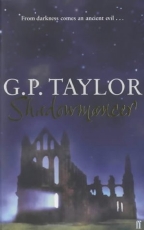Shadowmancer
G.P. Taylor
Faber
UK Trade Paperback
ISBN 0-571-22046-0
Publication Date: 19-06-2003
304 Pages; Price: £5.99
Date Reviewed: 01-06-04
Reviewed by: Katie Dean © 2004

REFERENCES
COLUMNS
|
|
|
ShadowmancerG.P. TaylorFaberUK Trade PaperbackISBN 0-571-22046-0Publication Date: 19-06-2003304 Pages; Price: £5.99Date Reviewed: 01-06-04Reviewed by: Katie Dean © 2004 |
|
|
REFERENCES |
COLUMNS |
'Shadowmancer' falls into the ever-growing category of fantasy fiction written for 'young adults' but equally enjoyable for older fantasy lovers. Set in a small corner of eighteenth-century England, it employs a fascinating mixture of religion, superstition and folklore in order to create a series of thrilling adventures. Like most fantasy novels, it focuses on the battle between the forces of good and evil. However, despite these many positive attributes, 'Shadowmancer' fails to live up to its potential, remaining a decent, but run-of-the-mill fantasy novel.
G.P. Taylor sets 'Shadowmancer' in a small area of England in the region of a town called Whitby. The descriptions of the area, combined with a helpful frontispiece map, bring the setting to life. It is defined by beliefs about folklore, including caves and holes allegedly inhabited by Hobs and other mythical creatures. The choice of era (1700s) also allows Taylor to introduce smugglers and highwaymen alongside the witches and creatures of superstition. Unfortunately, Taylor has made little attempt to recreate any other aspect of the eighteenth century, rendering his choice of setting nothing more than a tool of convenience to increase the novel's cast of characters.
The characters who populate this world are well-drawn caricatures of the type one might expect to find. From the evil Obadiah Demurral with his sidekick, Beadle, to the saintly Raphah, the cast is varied and interesting. Each is well suited to his or her literary purpose, if not entirely believable as a person. From the opening pages they race from one adventure to another as 'good' appears to have triumphed, only to face yet another obstacle. These mishaps have a tendency to be rather overtly contrived and never seriously shake the reader's belief that 'evil' will be overcome. Heaping adventure upon adventure serves to increase the level of excitement such that a truly spectacular ending is required in order to avoid anticlimax. Taylor rises to this challenge, providing yet another unexpected twist of fate and ultimately leaving plenty of room for a sequel.
The most interesting aspect of 'Shadowmancer' lies in Taylor's choice of theme. The usual battle between good and evil is given a slightly different twist. Rather than keeping with the tradition of light and dark magic, Taylor writes about the ultimate battle, that between God and the Devil. In today's world where Christianity is no longer fashionable in the Western world, yet religious fanaticism remains so apparent, this theme could be highly relevant. Unfortunately, rather than developing these ideas to their full potential, Taylor has restricted them to clumsy and clichéd reference points. The True religion is painted in terms of truth and light, bringing goodness, yet not easy to follow. The darker side is represented by magic and superstition and appears altogether more appealing. Rather clumsy allusions to the Fall of the Angels from Heaven and Messianic style miracles complete the picture. What a pity that such an interesting idea could not have been developed with more subtlety and elegance.
Overall 'Shadowmancer' must be rated as a 'good' read. Made compelling by its progression from one crisis to the next, it contains an appealing cast in an attractive setting. However, it is a great shame that it fails to reach its potential to become something more than this, perhaps a truly memorable fantasy novel.